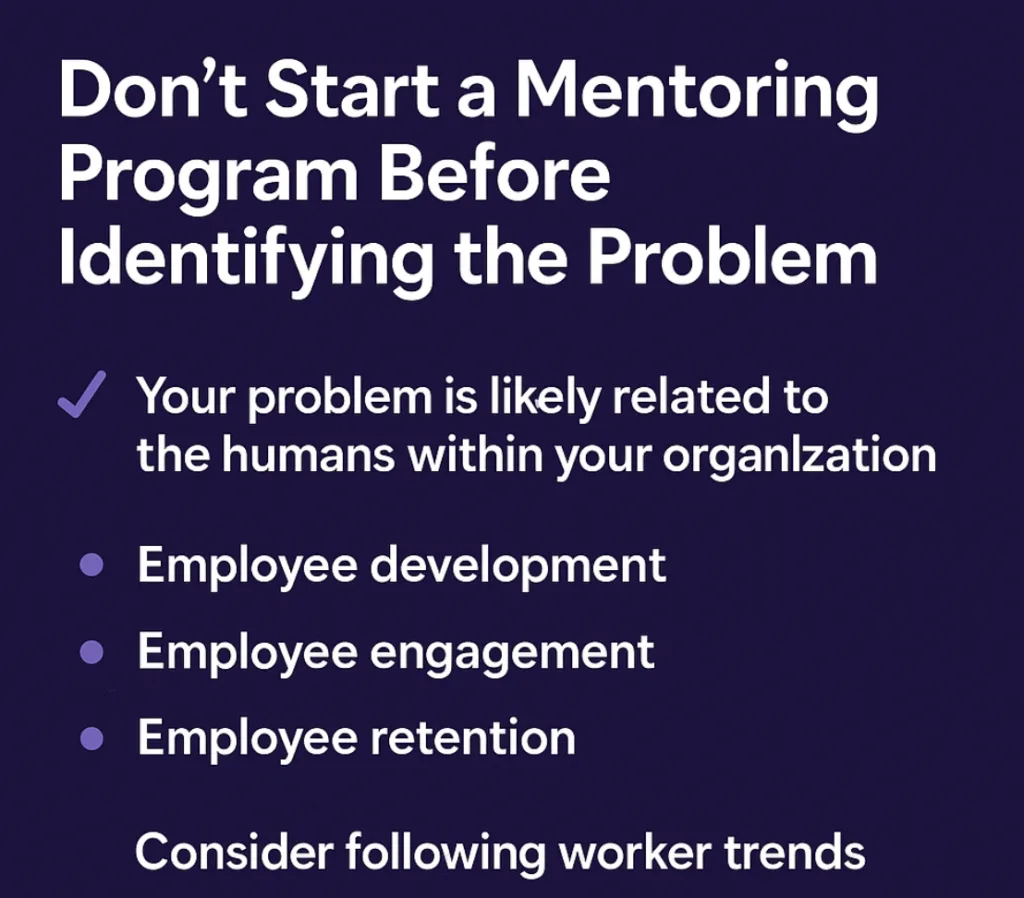Congratulations (or condolences)! You’ve been tasked with creating a mentorship program for your organization! But wait, where do you start? You can’t recall ever being in a mentoring relationship yourself, and for that matter, you’re not exactly sure what “mentoring” is. Is it coaching? Is it training? Is it counseling? All of the above, or none of these?
The process of creating a mentoring program can easily get out of control if you don’t take a structured and thoughtful approach. Our guide offers a 5-step process that will show you how to start a mentoring program in a way that reduces the stress and complications many people encounter when they build one for the first time. Our guide is built on our experience working with hundreds of clients across almost every industry who have successfully launched both small and enterprise-level mentoring programs.
This guide breaks the launch process down into the following 5 steps:
- Identifying and elaborating on the problem you’re trying to solve
- Exploring and selecting the type of mentoring programs that will solve that problem
- Aligning the program around measurable goals and objectives
- Drafting the program structure and needed resources
- Generating internal support from executive leaders
Once you’ve taken care of these 5 steps, your program will be ready to launch in no time!
Take it with you:
Download your action guide on How to Start a Mentoring Program right here
Don’t worry, and don’t panic. We are here to help you. In this article, we will share helpful tips and best practices for how you can start mentoring in your organization. You can read this in full or jump to specific sections below.
START AT THE TOP: Need a more extensive explanation of mentoring? Try our complete guide to mentoring.
How Do I Start a Mentoring Program?
Starting a mentoring program from scratch requires careful planning, patience, and internal support. Depending on the size and goals of your program, you may or may not need to obtain a budget. That’s something we’ll explore as we dig further into this guide. That said, the best way to start a mentoring program is to:
- Identifying your problem
- Pick a mentoring program format
- Draft the program structure and needed resources
- Choose measurable goals and objectives
- Get executive buy-in
Once each of these steps is taken care of, the speed with which you can launch your program will depend primarily on whether you’re running the program manually or with mentoring software (like MentorcliQ).
Consequently, if you’re trying to explore how to start a mentoring program for the first time, you’re going to need mentoring stats and other data that prove the value and impact that such programs will have on your organization. That kind of information will be critical to getting executive buy-in for your program.
When you begin planning for your mentoring program, keep these foundational items in mind to help you get set up for success:
- Set the purpose. Why are you doing this?
- Set the population. Who is this for?
- Set the structure. What type of structure will fit your population?
When you’ve defined purpose, population, and structure, you’ve set the foundation for the remaining program launch action items (success measurement and internal support). These elements will help you later design your communication plan along with a survey plan so that you maintain momentum throughout the life of your program.
While these questions are the main drivers of planning your mentorship initiatives, one thing to consider is that there may be additional questions you should ask to get the bigger picture of mentoring in your organization. Below are eight additional questions you can ask:
Step 1: Identify the Problem Mentoring Can Solve

We can’t stress this enough: Don’t try to start a mentoring program before you’ve identified the problem you think it can solve.
The good (bad) news here is that you have more problems than the day is long, so you won’t struggle to figure out a problem that exists. Given that mentoring is a human-focused strategy, your problem is almost always related to the humans within your organization. Among our own customers, the issues that drive mentoring program development fit into one of three categories:
- Employee development
- Employee engagement
- Employee retention
You can likely fit more specific needs under any of these categories. For example, MentorcliQ customer AMD found it needed more skill development and career development opportunities for its employees. The company built its programs on that need. Both would fall under the “Employee development” category.
You may also consider following worker trends.
According to Statista, over 50 million Americans participated in The Great Resignation in 2022. If you were building mentoring programs at that time, you likely were laser-focused on retention. Times have changed, however. The hiring market is stagnant, so people aren’t quitting in droves. Instead, we’re in the midst of an engagement and productivity crisis. If that rings any bells, you may be looking to launch mentoring programs focused on employee engagement.
Don’t forget to focus on the targeted population
It’s not enough to identify a problem; you also need to focus on a specific population of workers within your company who are either part of the problem (in the kindest possible sense) or who are impacted by it. Your mentoring program strategy will engage this population as both mentees and mentors, with the goal of positively impacting business objectives.
The way you configure and set up your eligibility criteria can change depending on who your mentees and mentors will be, so it is critical that you have a central audience in mind when you formulate your plans. This will help guide some subsequent decisions you have to make. To help you identify your core audience, answer the following questions:
- What audience are you trying to impact (e.g., high-potentials, new hires, new managers, women’s initiatives)?
- Who will be the mentee?
- Who will be the mentor?
- Will these groups be static, or can their roles change as the mentoring program progresses (i.e., can mentees become mentors)?
- Will people be required or invited to join?
- Can they choose to join your mentorship program or opt-out?
- How will you recruit new mentees and mentors?
- How will you encourage non-participants to join in future cycles?
Pro Tip: While it is good to be specific about the groups you want to target, try not to get too restrictive. This can significantly limit your mentor pool, which sets a lower limit on the number of mentoring matches you can make.
Example #1: Using a Global Open Program, here is a good example of a targeted population:
- Mentors: Full-time employees who have been with the company for at least a year and who are at a program manager level or above.
- Mentees: Full-time employees who have been with the company for at least 3 months
Example #2: Using a Global Open Program, here is a poor example of a targeted population:
- Mentors: Full-time employees who have been with the company for at least 5 years, have gone through the program managers’ skills experience course, and whose job title is Vice President or above.
- Mentees: Full-time employees
Unlike the first example, the mentor pool in the second example created barriers by being too specific and will likely not produce enough mentors to support a global open format. This population would be suitable for a smaller leadership development program that requires a targeted approach, but it’s too restrictive for an open format.
The key strategy here is to look at what your internal data is telling you. And if your internal data is weak, survey your employees to see if there’s a specific need that can be met with a mentoring strategy.
If you decide you are ready to begin the mentoring process or improve upon the design of an existing initiative, you will need to use the three foundational elements to further structure your plan.
High-level takeaway: Your primary actions for this step should include:
- Review internal data or conduct employee surveys to identify key business problems
- Verify that these problems exist and that they can be solved by mentoring
Step 2: Explore and select a mentoring program format that works best
Once you have identified the problem you want or need to solve, research and select one or more mentoring program types you believe will help you solve that problem.
This is a bit of a tricky part for a few reasons:
- Not all mentoring program formats solve every employee-related problem
- Some formats are better suited for smaller or larger programs
- How you measure organizational impact or success differs depending on the format
- You may not be familiar with the formats available and are unsure of where to start
Hopefully, that doesn’t increase your stress level. Ultimately, almost any mentoring program can solve most organizational problems. The format you choose may depend on your or your team’s preferred learning styles and the population you aim to impact with the program you select.
Common mentoring program formats that work
If you’re unfamiliar with different mentoring program formats, here are the ones that are most commonly used (and that MentorcliQ’s platform supports):
- One-to-one mentoring (traditional format): A single mentor pairs with a single mentee. Straightforward and classic, this is the most familiar style of mentoring.
- Group mentoring: One mentor guides multiple mentees—or even several mentors guide several mentees. It requires more thoughtful matching but is still widely used.
- Mentoring circles (occasionally called affinity circles): A facilitator leads open discussions with a circle of members. This flexible, modern format fosters dynamic peer learning and benefits from careful planning.
- Reverse mentoring: Junior employees mentor senior leaders, turning traditional roles upside-down. This format can stand alone or blend with 1:1 and group mentoring.
- Employee or Business Resource Groups (ERGs/BRGs): These employee communities naturally spark mentoring relationships and can be structured to improve visibility and tracking.
- Peer mentoring: Similarly-experienced employees mentor each other based on their individual talents, or collaborate on a shared topic, surfacing their individual learnings and ideas in each session.
Each format carries unique benefits and weaknesses. 1:1 traditional mentoring is great, but if you don’t have enough mentees to make it work, you may have to opt for a less personal group mentoring approach. And if you’re trying to upskill your leadership team, reverse mentoring makes the most sense, but only if you train your leaders on how to be humble and take mentorship from a junior-level employee.
Consider carefully each format. You may want to tease out a pro/con list for different formats and land on the one with the fewest downsides for your program’s needs and population.
Send the current outcome to your inbox
Step 3: Align your program around measurable business objectives and outcomes
I spent nearly a decade in education, and I always found the secret sauce to achieving goals for myself or my students was to focus on planning with the end in mind. For mentoring programs or any employee engagement, development, or retention strategy, that means tying the program to key business objectives.
Here’s where I need to say the obvious: “Increase revenue” is too obvious of a business objective to consider. Yes. Everything you do in HR should be focused on driving revenue growth. Hiring, firing, engagement, etc. Everything comes down to ensuring the company’s bottom line looks better year-over-year. Which is not to say you don’t want to measure the impact of your program on revenue in some way, but it’s altogether lazy to make that the only thing you measure. (Apologies if that offended anyone!)
There are many other measurable business impacts that you should be checking that speak to or lead to revenue impacts, which are heavily benefited by mentoring programs.
The type of business objectives you can measure in a mentoring program include, but are not limited to:
- Retention
- Internal mobility
- Productivity
- Absenteeism
- Job satisfaction
- Net Promoter Scores (NPS)
- Hiring statistics
- Inclusion metrics
See what I mean here? Your core business objectives are more than “make more money,” simply because making more money is influenced by a broad range of factors that extend beyond simply selling more of your products or services.
You will also need to measure the ROI of your mentoring programs, but that’s a given. ROI will generally be measured in something tangible, such as retention, but it can also be measured against other revenue-impacting business needs. That will only be possible if you have numbers attached to those needs.
Step 4: Plan out a functional mentoring program structure
Structure is everything for a mentoring program, and goes beyond just a format. Mentoring program structure includes:
- Matching strategy and timing: Define how mentors and mentees will be paired (algorithmic, manual, hybrid) and when matching cycles occur.
- Mentor and mentee training: Prepare participants with clear expectations, communication tips, and goal-setting resources.
- Meeting cadence and duration: Recommend how often pairs or groups should meet and for how long.
- Relationship guidelines: Outline expectations for confidentiality, goal setting, and feedback.
- Mid-cycle check-ins: Provide scheduled opportunities to gather feedback, address challenges, and maintain healthy relationships.
- Program kickoff and closing: Begin with a launch event or orientation and conclude with recognition or reflection activities.
- Measurement and success metrics: Define how you’ll track progress, from participation rates to skill development or retention outcomes.
- Support resources and communication plan: Offer FAQs, conversation starters, and regular updates to keep participants engaged.
- Technology and tools: Identify the platform or system to manage sign-ups, scheduling, and reporting.
- Scalability and sustainability plan: Plan for growth, ensuring you can add participants or replicate the program across departments.
Your matching strategy is by far the most critical part of your mentoring program design. If you don’t match effectively, your program will go nowhere.
MentorcliQ’s automated matching software allows you to match mentors and mentees at scale. From there, you can manage and measure the success of your programs with a modern interface. You can even start small with 100 participants using MentorcliQ’s low-cost CliQ Start package.
A strong structure gives mentors and mentees confidence and clarity. By providing training, setting meeting expectations, and scheduling regular check-ins, you remove friction and create a consistent experience. Kickoff and closing activities create a sense of community and accomplishment, while clear success metrics demonstrate the program’s value to leadership.
Finally, leveraging technology and planning for growth ensures the program remains efficient and adaptable as your organization evolves. In short, structure isn’t just an administrative step—it’s the backbone that turns mentoring from a good idea into an enduring, impactful strategy.
In many ways, this is where you combine steps 1-3 into something more coherent before stepping into Step 5.
Step 5: Get executive approval and launch
The last step is undoubtedly the most difficult one. Building internal support for mentoring can be a hurdle, especially if this is an initiative you’re trying to launch yourself and not one that executive leaders have tasked you with building.
This is a topic that is quite near and dear to our hearts because we have heard every argument in the book for why people can’t convince their leaders mentoring works:
- “You can’t prove ROI.”
- “We already have a mentoring module in Workday.”
- “Mentoring is too soft; we need hard skills development.”
- “It’ll distract employees from doing their jobs.”
Yadda yadda, yackity yackity yak. Ultimately, most leaders are overly cautious and don’t want to invest time or resources into employee development or retention programs unless they see it as a sure win.
You could get lucky and have leaders who were beneficiaries of mentoring in their own careers. Those individuals are usually easy to convince and will help you cheerlead your goal to launch a mentoring program. We tend to call them Champions. They’re not only the executive leaders who will help lead the charge for you, but they’re your single-best assets in getting the budget and approvals you need to launch your program.
All that being said, to build executive support and launch your program, use this simple playbook:
- Create a structured, clean, and organized presentation that outlines your program goals, design, and expected business-impacting outcomes.
- Share this with someone in your leadership team who you know (or suspect) could be a Champion. Get their insights and feedback on how to sell mentoring internally.
- Edit or improve your slide deck, then practice presenting it for a flawless delivery.
- Meet with executive leaders or decision makers and deliver your presentation.
- WIN. Get approval and start the launch process.
Sure, #5 isn’t a given, but it’s more likely to happen if you follow this playbook. It’s also more likely if you download our critical resource designed to help you with winning over executive leaders:
Download our guide to Selling Employee Development Internally
Real-World Examples of Successful Mentoring Programs
Our page on Customer Success Stories will help inspire you. There, you’ll find videos from household brands like AMD, LinkedIn, Cigna, and more, on how and why building mentoring programs with MentorcliQ was a success.
Here are three additional examples of mentoring programs we helped our clients craft and launch.

Lifelong Career Development at KeyBank: KeyBank is a regional bank with a strong culture of career development. Their program is geared towards retention and helping their people develop their life-long careers at KeyBank. This comes through strongly in their design as they encourage their people to “bring your own aspirations”.
As an organisation-wide initiative, participants can self match, and both parties specifies what kind of relationship they are looking for. These design points along with many others help KeyBank meet their goals.
The biggest and most exciting result is the bottom line impact on the organization. Their return on investment (ROI) is measured in millions of dollars by increasing retention by 76%. Read more of KeyBank’s story.


Strong Inclusive Cultures at Cardinal Health: Mentoring has always been part of the strong inclusive culture at Cardinal Health. As a key element to its global talent management strategy, Cardinal Health has championed mentoring to offer individualized learning experiences to their people to help them grow personally and professionally.
In 4 short years Cardinal Health expanded their reach to over 20 mentorship programs across the United States, Canada, Mexico, Caribbean, and Asia Pacific regions, spanning topics in career development, functional expertise, and diversity and inclusion.
The benefits this had at Cardinal Health speaks for itself. With incredibly high employee experience scores, 97% satisfaction across the mentoring population, Cardinal Health was able to save over $5 million through employee retention with their initiative. Read more of their story.

Award Winning Diversity & Inclusion with Nielsen: Nielsen’s Global MyMentor makes mentoring available across Nielsen’s entire workforce and in support of their broader diversity and inclusion goals to ensure every associate has access to professional development opportunities. In their first 9 days, they enrolled over 2,500 people across each of the 80+ countries in which they operate.
Within 8 weeks, this number expanded to include over 15% of their workforce, with their associates being engaged in mentoring, with over 16,800 hours being invested in the initiative by their associates. In 2020, Nielsen won a Brandon Hall award for Best Diversity & Inclusion Strategy supported by their Global MyMentor program. Watch more of their story.

8 Important Questions for How to Start a Mentoring Program
As you start planning out launching a mentoring program, keep these questions in mind:
- What is your overall vision and objective?
- Are there already mentorship programs that are up and running at your company?
- How are you currently using mentoring at your company? Which business problems or challenges does it address?
- How many people take part as mentees and mentors?
- Do you want to improve what already exists, expand what exists, or start from scratch?
- Who is in charge of initiatives that already exist (what department or group owns it)?
- Do you have the power, budget, resources, etc. to enact changes?
- Do you need to get the support of others to bring mentoring to your company or to change how you have been doing things?
Once you have answered these questions…
You can start to see the bigger picture for designing initiatives at your company. You may already have something in place that addresses the demands of high-potentials or that is part of a larger onboarding process.
Knowing where mentoring already operates and how it is being used will help you form a vision of what you want to accomplish with your plans. From there, you can begin the work of designing and planning and forming your plan to meet your needs.
For more advice on launching programs, be sure to bookmark the following pages:
- How Do I Run a Successful Mentoring Pilot?
- Modern Mentoring 2.0: The New Way to Run Mentoring Programs
- Leverage Virtual Mentoring to Engage Your Newly Virtual Workforce
- Mentoring Programs Formats
- Keys to Creating a Mentoring Culture
You’ve taken the first step to starting a mentoring program. Now keep going!
We Can Help! All great ideas start somewhere… Regardless of where you start the process, the fact that you want to implement mentoring is a positive goal. We have helped hundreds of organizations design, launch, run, and manage mentoring programs over the years, and we’d love to help you too. Contact us to discuss your ideas, vision, and goals. Our experts are here to help. Because at MentorcliQ, we believe you can do more with mentoring.




